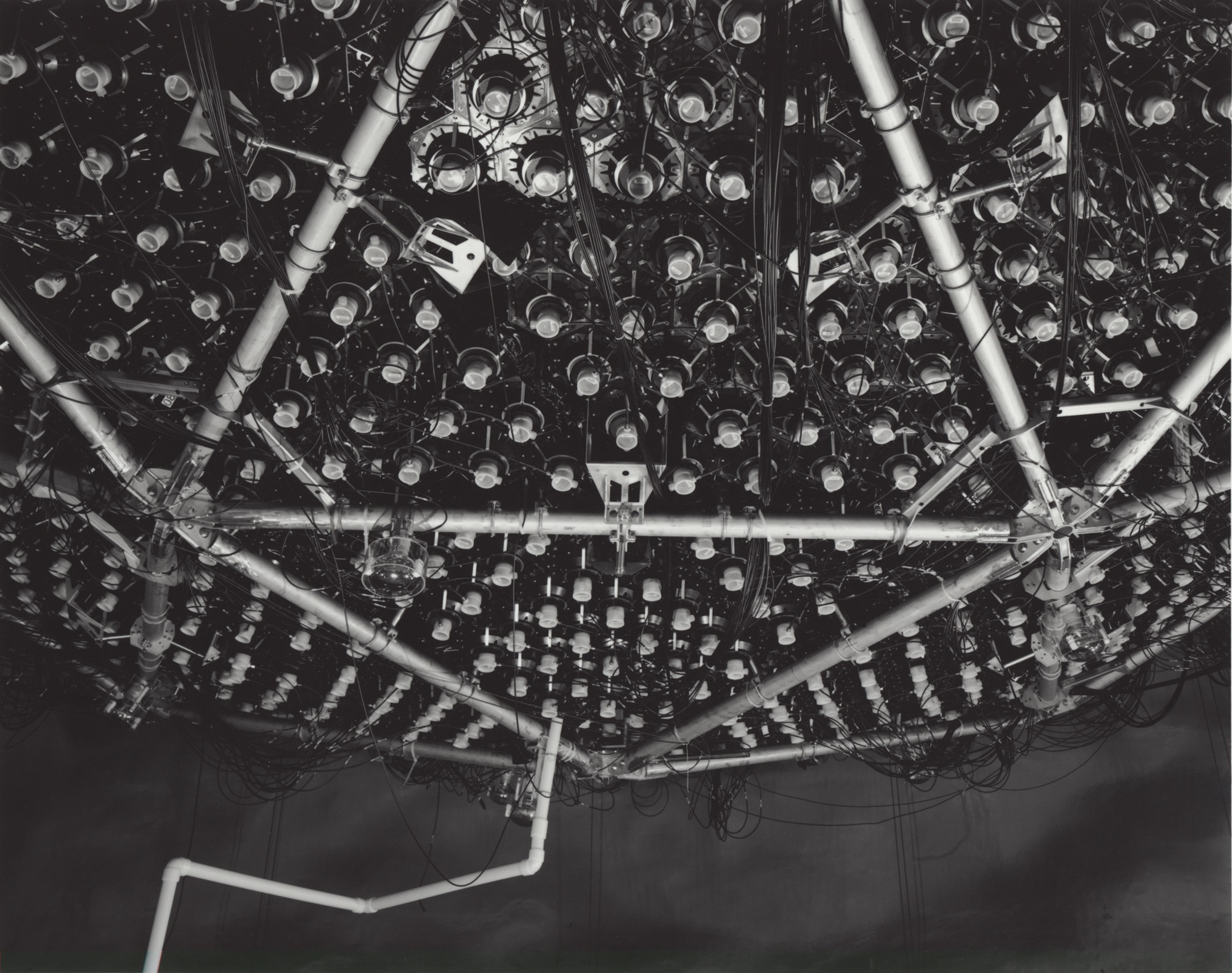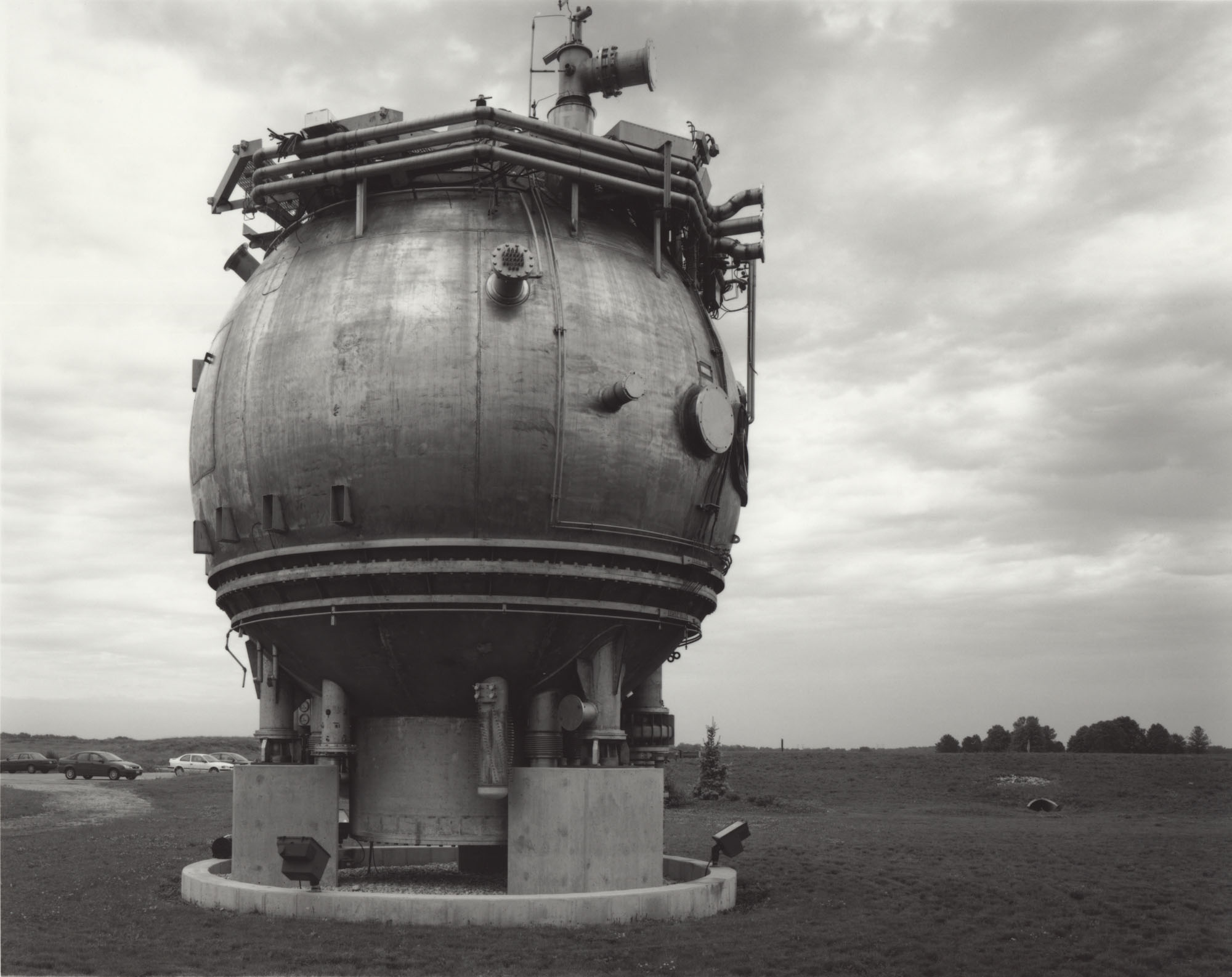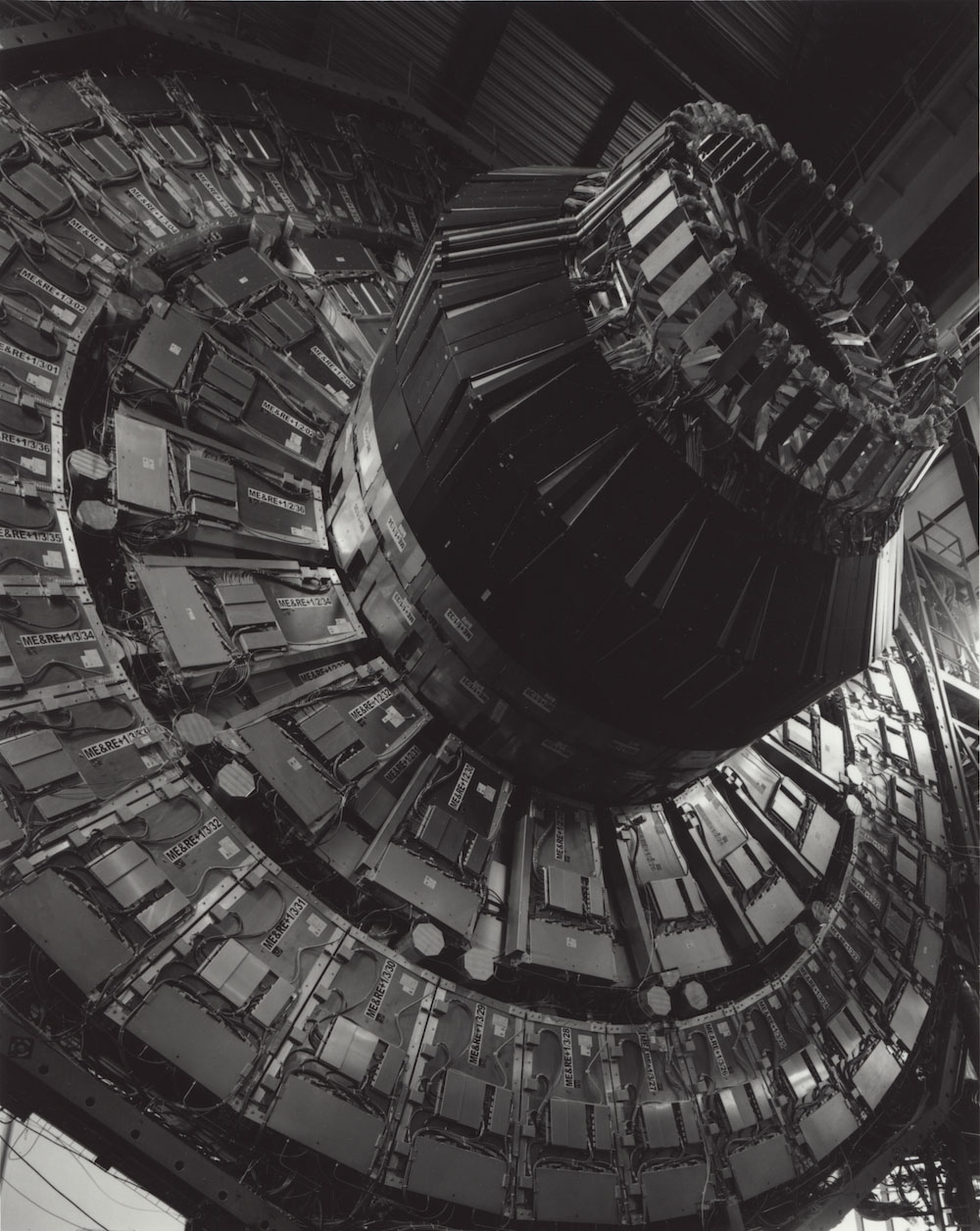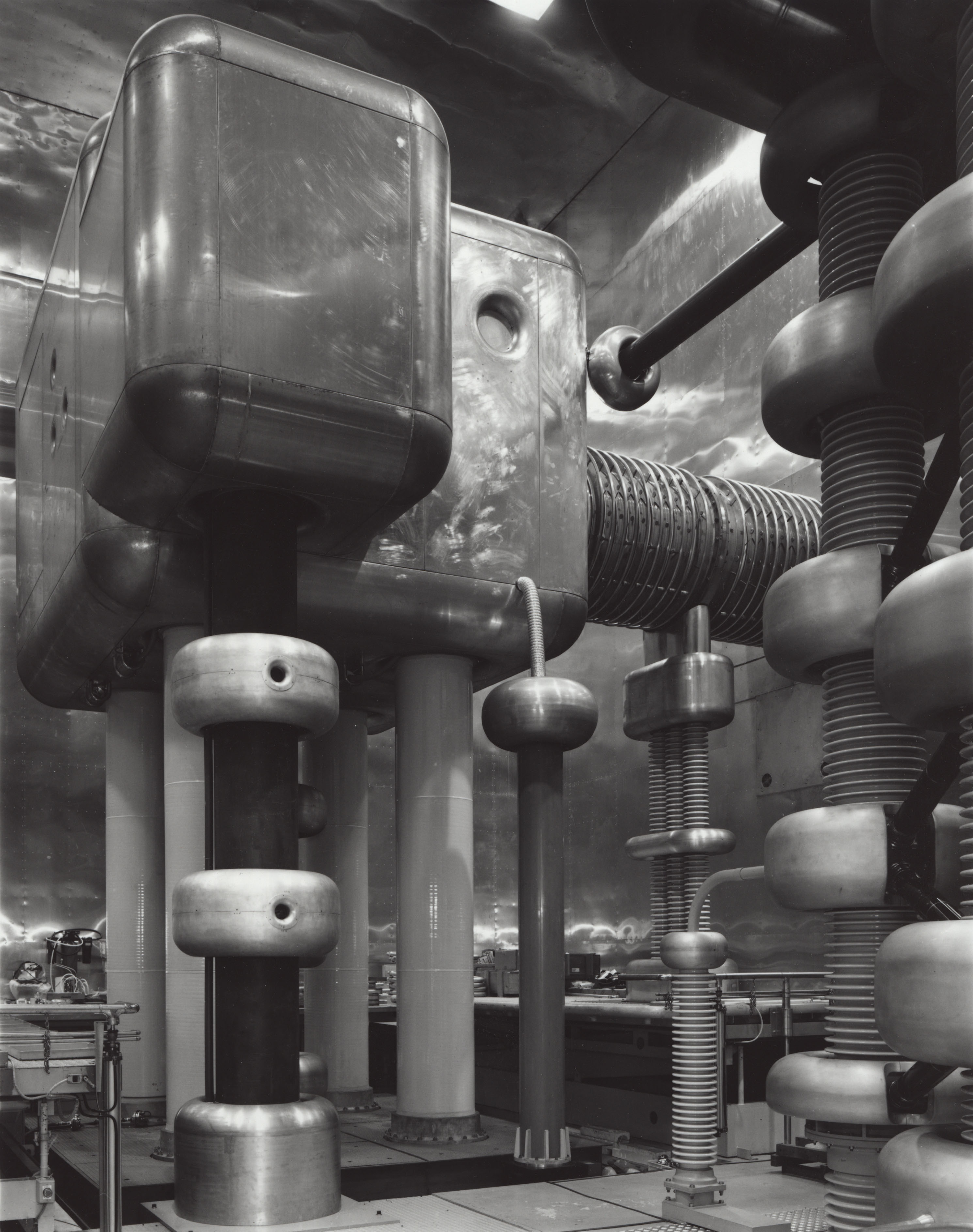Chasing Time Machines: A Photographer Turns High Energy Physics Into Art
Stanley Greenberg takes pictures of giant structures used to study tiny particles.

The SNO (Sudbury Neutrino Observatory) detector (2009). The detector was originally built to detect neutrinos produced by fusion reactions in the sun. Neutrinos reacted with heavy water contained within the detector, producing flashes of light that were then picked up by an array of photomultiplier tubes—which convert light into an electrical signal—anchored to a geodesic structure. Plans are underway to upgrade the SNO detector for a new experiment, according to SNOLAB's website. Photo by Stanley Greenberg
In 2008, photographer Stanley Greenberg donned full mining gear—including a borrowed suit a few sizes too big—and trudged through a rocky tunnel coursing under Ontario, Canada. The trek eventually led him more than a mile down to SNOLAB, an astroparticle physics research facility located in the bowels of Vale Creighton Mine. There, he changed into clean room clothing in preparation for his final destination—the SNO detector, a contraption originally built to hold 1,000 tons of heavy water used to identify neutrinos produced by fusion reactions in the sun. Equipped with a geodesic sphere spanning about 60 feet in diameter, the detector slumbers in a manmade cavern 6,800 feet within the mine’s trenches.
At the precipice to the detector, Greenberg strapped into a harness and then lowered into darkness, his camera in an accompanying basket. A few safety lights gave him the illumination he needed to snap long exposures of the majestic structure. One of those images is was part of Stanley Greenberg: Time Machines, a series of physics-themed black-and-white photographs that was on exhibit at the MIT Museum in Cambridge, Massachusetts in 2013 and 2014.

The 15-foot bubble chamber at Fermi National Accelerator Laboratory in Batavia, Illinois (2006). No longer in operation, the chamber once allowed Fermilab physicists to study elusive high-energy particles such as kaons, lambdas, and electrons. When such particles were introduced into the chamber—which contained superheated hydrogen—they left bubble tracks that could be photographed and analyzed, according to Fermilab Today. Photo by Stanley Greenberg
Greenberg—who had previously shot New York’s most remote recesses, such as valve chambers in water tunnels 300 feet below the city—spent more than three years crisscrossing the globe to photograph the often enigmatic and inaccessible world of nuclear and high energy physics research. Fascinated by the massive machines and power required to investigate the tiniest of particles, he was also struck by how little other people seemed to know about these experiments. Friends who were connoisseurs of great novels, music, and art were typically unaware of facilities such as SNOLAB, CERN in Switzerland, and the IceCube Neutrino Observatory in Antarctica. He found himself wondering: “How can you not be interested in something as elemental as this? This is how the universe works.”
[Physicists have taken the first measurement of a neutrino interacting with the nucleus of an atom.]
Greenberg’s curiosity impressed Janet Conrad, a professor of physics at MIT who helped him plan a visit to Fermilab in Illinois. Conrad, who often gives public talks about physics, finds that lay audiences typically associate the discipline with three things: E=mc2, bombs, and the notion that it’s hard to understand. “I find this very disconcerting, especially the ‘bombs’ answer,” she says. “When I think of physics, I think of music, and auroras, soap bubbles, and tiny universes that we make in our particle interactions.”

One of the end-caps (YE-1) of the Compact Muon Solenoid (CMS) detector, part of the Large Hadron Collider at CERN in Geneva, Switzerland (2006). The CMS is involved in a wide range of physics investigations, including research into the Higgs boson and the search for particles that could make up dark matter. The detector is built around a huge solenoid magnet in the form of a cylindrical coil of superconducting cable that generates a field of four tesla—about 100,000 times the Earth's magnetic field, according to CERN's website. Photo by Stanley Greenberg
By focusing on the “architecture of science”—that is, the structure and design of giant machines like the SNO detector—Greenberg makes the world of minute particles more comprehensible to the public, says Gary Van Zante, curator of architecture and design at the MIT Museum and the exhibit’s curator. Indeed, while international teams of scientists work at these physics facilities, the design of each reflects the aesthetics of the country in which it’s based, says Greenberg. He describes how the Laboratori Nazionali di Frascati in Italy “looked Italian, the ones in the U.S. looked less stylistic, and [the High Energy Accelerator Research Organization in Japan] had beautiful concrete.”

The Cockcroft-Walton accelerator at Japan’s High Energy Accelerator Research Organization (KEK) (2008). The Cockcroft-Walton accelerator was introduced in 1932 and was the first apparatus to artificially accelerate atomic particles to high energies, according to Nature. KEK’s Cockcroft-Walton device, still in use, accelerates to 800,000 volts, according to Janet Conrad, a physics professor at MIT. Fermilab also has a Cockcroft-Walton accelerator, now out of operation. Photo by Stanley Greenberg
Greenberg’s photographs—printed in the traditional way, on silver gelatin—stand out for their craftsmanship, says Van Zante. But they’re also an “important historical record of these experiments,” says Conrad. For his part, Greenberg says that each composition “is as much about art as it is science,” adding that, “Hopefully people from both fields will want to look at them.”
The exhibit Stanley Greenberg: Time Machines opened on September 13, 2013 and ran through March 30, 2014 at the MIT Museum. His photographs are also available in his book Time Machines.
Becky Fogel is a newscast host and producer at Texas Standard, a daily news show broadcast by KUT in Austin, Texas. She was formerly Science Friday’s production assistant.